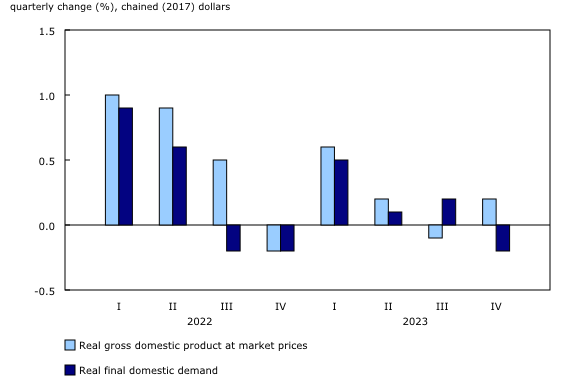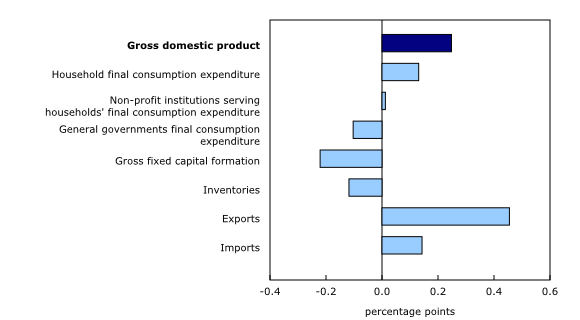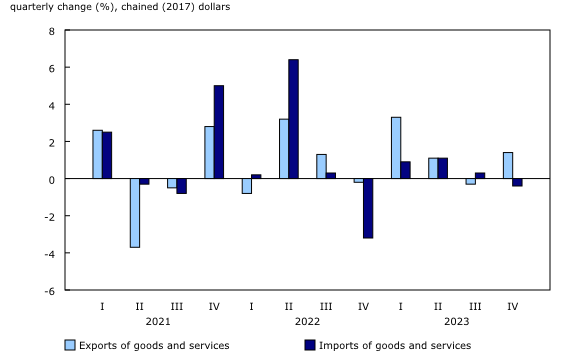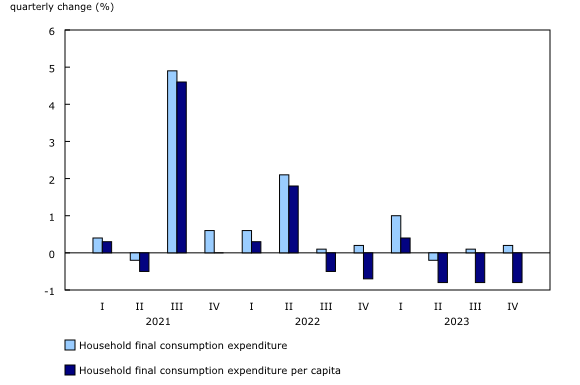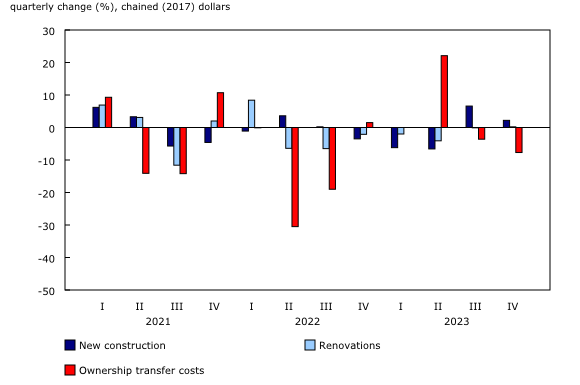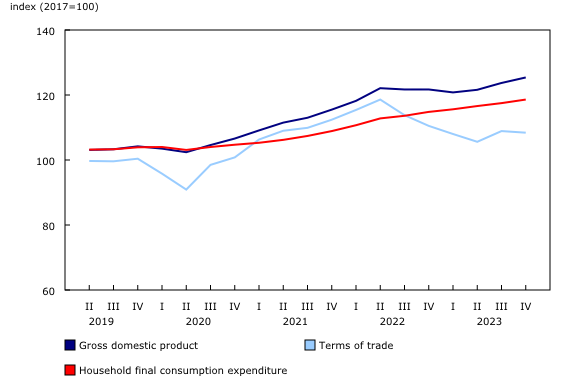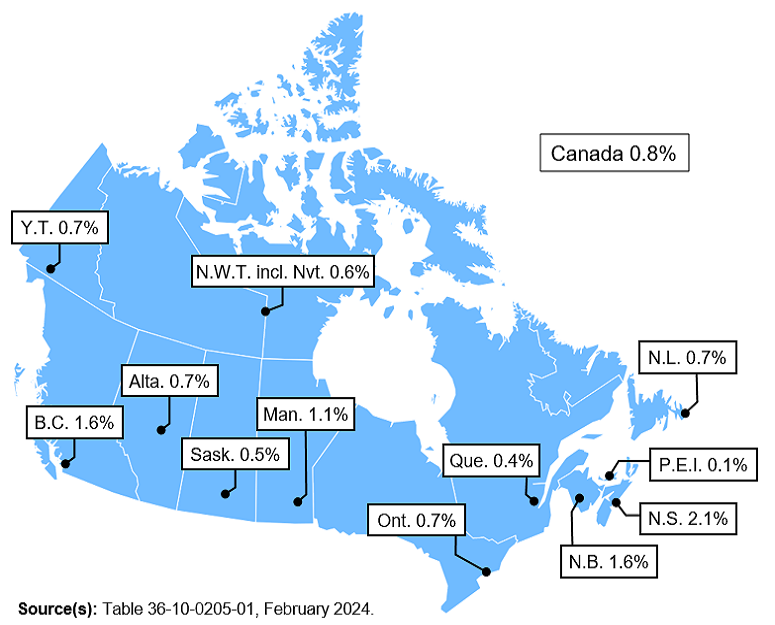Gross domestic product, income and expenditure, fourth quarter 2023
Released: 2024-02-29
Real gross domestic product (GDP) edged up 0.2% in the fourth quarter of 2023, following a 0.1% decline in the third quarter. In the fourth quarter, higher exports and reduced imports fuelled GDP growth, but this was moderated by a decline in business investment.
Final domestic demand, composed of expenditures on final consumption and gross fixed capital formation, edged down 0.2% in the fourth quarter, after a 0.2% increase in the previous quarter. On an annual basis, real GDP and final domestic demand rose for the third consecutive year since the COVID-19 pandemic-induced contraction in 2020. However, outside of 2020, real GDP in 2023 rose at its slowest pace since 2016.
Exports fuel real gross domestic product growth
Exports of goods and services rose 1.4% in the fourth quarter, following a 0.3% drop in the third quarter. The increase was driven by crude oil and crude bitumen exports (+6.2%), which coincided with sustained production of crude oil in Alberta, as well as that of travel services and other transportation equipment and parts.
Imports of goods and services declined 0.4% in the fourth quarter, after rising 0.3% in the third quarter of 2023. The decrease was led by lower imports of intermediate metal products, tires, motor vehicle engines and parts, and passenger cars and light trucks.
For the year 2023, exports of goods and services rose 5.7%, outpacing the 1.0% increase in total imports. The stronger export growth was led by increased exports of passenger cars and light trucks as well as travel services. Meanwhile, import growth was driven by increases in travel services and passenger cars and light trucks due to strong Canadian demand.
Household spending edges up
Household spending increased 0.2% in the fourth quarter, after edging up 0.1% in the third quarter. The increase was led by higher spending on new trucks, vans and utility vehicles as supply chain issues continued to ease and back orders were fulfilled. Overall growth was dampened by a decline in expenditures by Canadians abroad (-4.8%) and an increase in spending by non-residents in Canada (+4.4%), which is a negative contributor to household spending.
Population growth continued to outpace the rise in household spending in the fourth quarter, as per capita consumption expenditures declined for the third consecutive quarter.
Growth in household spending slowed to 1.7% in 2023 from 5.1% the previous year, boosted by increased spending on new trucks, vans and utility vehicles.
Housing investment declines
Housing investment was down 0.4% in the fourth quarter, a sixth decline in the last seven quarters. Despite increased activity in new construction (+2.2%) and renovations (+0.2%), the resale market weakened across Canada, which offset increased housing investment, as ownership transfer costs fell 7.7% in the fourth quarter. Single units and apartments led the increase in new construction, as all provinces and territories, except Prince Edward Island, saw an increase in housing starts.
On an annual basis, residential construction was down 10.2%, with declines occurring in new construction, renovations and ownership transfer costs. In nominal terms, housing investment represented 7.7% of GDP in 2023, a significant decline from the peak of nearly 10% in 2021.
Business investment declines
Real business investment declined for the sixth time over the last seven quarters. Investment in non-residential structures fell 3.0% in the fourth quarter, owing to decreased expenditure on engineering structures. Investment in machinery and equipment (-1.4%) continued to decline in the fourth quarter, largely because of lower spending on aircraft and other transportation equipment, which coincided with a decline in imports of aircraft.
Business spending on intellectual property products edged down 0.2% in the fourth quarter, while lower spending on mineral exploration (-2.2%) was partly offset by higher spending on research and development (+3.5%).
Slowing investment in inventories dampens gross domestic product
Businesses continued to add to their inventories in the fourth quarter (+$30.4 billion) but at a slower pace compared with the third quarter (+$34.7 billion). The moderating impact of lower accumulations in retail and wholesale trade inventories were partly offset by higher manufacturing inventories, particularly refined petroleum, primary metals, machinery and motor vehicles. While investment in non-farm inventories slowed in the fourth quarter, this was partly offset by an accumulation of farm inventories amounting to $3.6 billion. The economy-wide stock-to-sales ratio, the stock of business inventories as a proportion of aggregate demand, reached 1.079 in the fourth quarter. Excluding inventories of gold and other precious metals, the ratio stood at 0.936.
Terms of trade down in fourth quarter and the year
The ratio of the price of exports to the price of imports—the terms of trade—fell 0.5% in the fourth quarter, as the increase in prices of imported products (+0.8%) surpassed that of exported products (+0.3%). Overall, the terms of trade fell 5.9% in 2023, as export prices declined 3.8% after strong increases in the previous two years.
The GDP implicit price index—a measure of economy-wide prices—rose 1.4% in the fourth quarter, the third consecutive quarterly increase. The increase was widespread, with notable increases being in prices of government final consumption (+2.4%) and household spending on services (+1.4%). For the year 2023, prices of household final consumption expenditure, excluding food and energy, were up 3.7%; however, this was a deceleration compared with a 4.1% increase in 2022.
Compensation of employees rises at slowest pace since second quarter of 2020
Compensation of employees rose 0.8% in the fourth quarter of 2023, the slowest growth rate since the second quarter of 2020. The lower growth in the fourth quarter of 2023 reflected slower wage growth in services producing industries relative to the previous quarter, as well as declining wages in the goods-producing industries.
Total wages and salaries in federal government public administration increased 11.9% in the fourth quarter, largely because of a significant retroactive payment to federal government employees. A decline in educational services (-1.0%) during the fourth quarter was associated with strike action in Quebec's education industry in November and December 2023.
In 2023, compensation of employees grew 6.5%, a slower pace than in 2022 (+9.2%). In 2023, growth was strongest in Prince Edward Island (+8.2%), Nova Scotia (+8.0%) and New Brunswick (+7.3%) and was slowest in Saskatchewan (+5.0%).
Household net saving remains stable
The household saving rate was little changed in the fourth quarter, at 6.2%, as disposable income and spending rose at nearly the same pace. Income gains were roughly equally split among compensation of employees, business income and net investment incomes. The latter benefitted from a combination of higher investment earnings and the moderating effect of interest payment pressures. The household saving rate was 5.5% in 2023, well above that observed before the pandemic.
Household property income payments, comprised of mortgage and non-mortgage interest expenses, rose 1.6% in the fourth quarter, the slowest pace since the first quarter of 2022, when the Bank of Canada's series of policy rate increases began. Since then, household interest payments have more than doubled. Lower income households tend to be more negatively affected by interest rate increases through property income paid, while those with variable-rate debt tend to be impacted more immediately than those with fixed-rate loans. By contrast, in the fourth quarter, property income received by households, which includes deposit interest and other investment income, was up 4.3% from the third quarter and by nearly 33% since the first quarter of 2022. Higher income households tend to benefit more from interest rate increases through property income received.
Corporate incomes continue to grow
In the fourth quarter of 2023, corporate incomes increased 2.9%, after rising 3.4% in the third quarter. The expansion of gross operating surplus of non-financial corporations (+3.3%) fuelled the continued increase, while declining surplus among financial corporations (-1.8%) partly offset overall corporate income growth.
The increase in the non-financial sector in the fourth quarter was led by wholesale and retail trade and growth in the telecommunications and other services industries. The energy sector had a lower gross operating surplus due to lower prices and temporary shutdowns of some oil refineries for maintenance.
The gross operating surplus of financial corporations continued to decline in the fourth quarter, owing to narrowing net interest margins at chartered banks in the wake of central bank rate increases. The decline in financial sector gross operating surplus has persisted since the second quarter of 2022.
Did you know we have a mobile app?
Get timely access to data right at your fingertips by downloading the StatsCAN app, available for free on the App Store and on Google Play.
Sustainable development goals
On January 1, 2016, the world officially began implementing the 2030 Agenda for Sustainable Development—the United Nations' transformative plan of action that addresses urgent global challenges over the following 15 years. The plan is based on 17 specific sustainable development goals.
Data on gross domestic product, income and expenditure are an example of how Statistics Canada supports the reporting on global sustainable development goals. This release will be used to measure the following goals:


Note to readers
Gross domestic product (GDP) data for the fourth quarter have been released along with updated data from the first quarter of 2023. Updates to the first quarter to the third quarter of 2023 were due to the incorporation of updated source data and of preliminary estimates from the Capital and Repair Expenditures survey and the intentions estimates from the Gross domestic expenditures on research development. Additionally, Balance of Payments estimates of travel services have been revised from the first quarter to the third quarter of 2023 to incorporate the latest information from the Visitor Travel Survey, which resumed partial collection in 2023 and has provided more detailed spending information with which to estimate the expenditure of non-residents within Canada.
Revisions to Canada's gross domestic product
To satisfy the opposing goals for both timeliness and accuracy, Statistics Canada regularly updates (revises) its estimates of Canada's GDP. Further details are outlined in the following article, "Revisions to Canada's GDP."
Accounting for e-commerce transactions with non-resident vendors
The indicators used to estimate Household Final Consumption Expenditure have been adjusted to account for non-resident e-commerce sales. The Monthly Retail Trade Survey collects data only on resident vendor e-commerce sales. The non-resident vendor e-commerce adjustment, which is applied to the indicators to estimate household consumption, mainly the Retail Commodity Survey, is a non-seasonally adjusted, quarterly value. This adjustment has been in place since the fourth quarter of 2019. For the fourth quarter of 2023, the adjustment represents 909.4 million dollars, applied to the household consumption indicators. The adjustment is derived using sources such as details from customs transactions, Goods and Services Tax remittances and financial statements for certain enterprises.
General
Percentage changes for expenditure-based statistics (such as household spending, investment, and exports) are calculated from volume measures that are adjusted for price variations. Percentage changes for income-based statistics (such as compensation of employees and operating surplus) are calculated from nominal values; that is, they are not adjusted for price variations. Unless otherwise stated, growth rates represent the percentage change in the series from one quarter to the next: for instance, from the third quarter of 2023 to the fourth quarter of 2023.
For information on seasonal adjustment, see Seasonally adjusted data – Frequently asked questions.
Real-time tables
Real-time tables 36-10-0430-01 and 36-10-0431-01 will be updated on March 11, 2024.
Next release
Data on GDP by income and expenditure for the first quarter of 2024 will be released on May 31, 2024.
Products
The data visualization product "Gross domestic product by income and expenditure: Interactive tool," which is part of the Statistics Canada – Data Visualization Products series (71-607-X), is now available.
The document "Revisions to Canada's GDP," which is part of Latest Developments in the Canadian Economic Accounts (13-605-X), is now available.
The document, "Recording new COVID measures in the national accounts," which is part of Latest Developments in the Canadian Economic Accounts (13-605-X), is available.
The Economic accounts statistics portal, accessible from the Subjects module of the Statistics Canada website, features an up-to-date portrait of national and provincial economies and their structure.
The User Guide: Canadian System of Macroeconomic Accounts (13-606-G) is available.
The Methodological Guide: Canadian System of Macroeconomic Accounts (13-607-X) is available.
Contact information
For more information, or to enquire about the concepts, methods or data quality of this release, contact us (toll-free 1-800-263-1136; 514-283-8300; infostats@statcan.gc.ca) or Media Relations (statcan.mediahotline-ligneinfomedias.statcan@statcan.gc.ca).
- Date modified:


